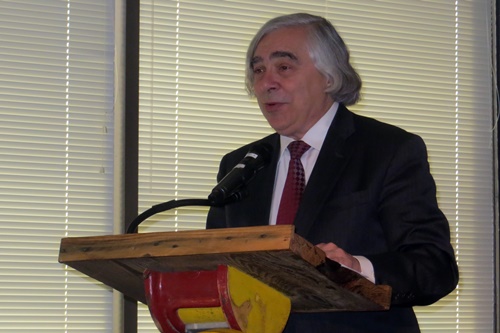23 November 2015. Advanced Research Projects Agency-Energy, or ARPA-E, the agency funding riskier energy research and development initiatives in the U.S., announced funding for 41 new projects, including those at 19 private companies. The grants totaling $125 million were revealed today by Secretary of Energy Ernest Moniz at 1776, a technology incubator and seed fund in Washington, D.C.
Moniz underscored the key role of innovation in advancing technology to meet climate change goals in preparation for the U.N. conference on climate change, known as Conference of Parties or COP21 scheduled to begin 30 November in Paris. Innovation, says Moniz, will be a a major theme in Paris, since it’s a key driver in the adoption of technologies to mitigate the effects of climate change. “Innovation in this space,” noted Moniz, “keeps driving down costs of these technologies.”
ARPA-E funds research on advances in high-impact energy-related technologies deemed too early or risky for private sector funding. This latest group of grants were the result of an open-call for proposals, only the third such open call since 2009. Most ARPA-E funding rounds are related to specific agency priorities or themes. The competition for funding is highly competitive, with these 41 new projects representing only about 2 percent of all submissions. Moniz, who was a professor pf physics at MIT before becoming energy secretary, pointed out that “it is easier to get into MIT than to get an ARPA-E award.”
Of the 41 grants, 19 were awarded to private companies, with about the same number going to university researchers, and the remainder awarded to national labs and non-for-profit institutions. Of the private industry awards, a few went to major corporations including General Electric and Corning Inc., but most went to small, early-stage enterprises.
Among the recipients of 2015 ARPA-E grants is Marine BioEnergy Inc. in San Diego, a developer of acquaculture systems. In this project, Marine BioEnergy plans to create a cultivation system for algae biomass for biofuels in the open ocean that takes advantage of its water and sunlight, but can still submerge in times of storms or to avoid ships in the vicinity. With its $2.1 million award, the company plans to grow its crop in the the U.S. Economic Exclusion Zone off California.
Another private sector grant recipient is Mackinac Technology Company in Grand Rapids, Michigan, a developer of window insulation systems designed to work with existing windows and frames in residential and commercial buildings. With its $2.5 million grant, Mackinac Technology is creating a transparent film that lets in more than 90 percent of sunlight, yet reflects ultraviolet and thermal-infrared energies to reduce heat loss in winter.
Proton Onsite, in Wallingford, Connecticut is receiving a $2.5 million award to develop a hydrogen-iron flow battery that plans to generate hydrogen for fuel cell vehicles, as well as store energy for the power grid. The device is expected to recharge either with electricity from the power grid or from exposure to sunlight. The company says its dual hydrogen generator and grid battery operates at a higher rate of efficiency than conventional electrolyzers that split water into hydrogen and oxygen.
Read more:
- New Design Advances Lithium-Air Battery
- Universal Wireless Charging Device Designed
- Navy Seeks Graphene Nanoribbons for Electricity Distribution
- Material Developed to Prevent Li-Ion Battery Fires
- UC-Davis, National Labs to Train Science Entrepreneurs
* * *


 RSS - Posts
RSS - Posts
[…] ARPA-E Funding 41 Energy Generation, Efficiency Projects […]
[…] Standard Devised to Cut Poultry Antibiotic Use […]